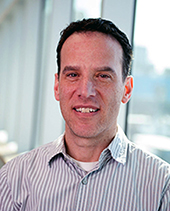Skip to content. | Skip to navigation
Personal tools

- Contact Us |
- Seminars |
- Donate

Lunenfeld- Tanenbaum
Research Institute
Mount Sinai Hospital
Joseph and Wolf Lebovic Health Complex
600 University Avenue
Toronto, Ontario
M5G 1X5
Tel.: 416-586-4800 ext.4122
► Web of Science Researcher ID
D-5092-2015
Dr. Ian M. Rogers
SCIENTIST
Dr. Rogers’ lab is focused on developing three dimensional tissue culture systems to improve stem cell studies. By combining stem cells with decellularized organs, his aim is to advance studies on stem cell differentiation, cell-cell signaling and understanding the complex three-dimensional organization of cells into functional organs and tissues.
His research focuses on the following areas:
Cell therapies
Blood cells and mesenchymal cells from umbilical cord blood or tissue are a suitable source of cells for regenerative medicine to treat peripheral vascular disease (PVD) and non-healing skin wounds. For the treatment of PVD and non-healing wounds the ability of transplanted blood and mesenchymal cells to induce tissue repair mechanisms in endogenous cells is being investigated. The lab has demonstrated that CD34+ blood cells or mesenchymal stromal cells from umbilical cord tissue or blood can be isolated, grown in vitro, during which they develop the ability to secrete factors that support cell survival, blood vessel growth and cell migration important for tissue repair.
Reproduction
The goal of this project is the development of a tissue culture system that will improve studies in the area of reproduction. In collaboration with Dr. Greenblatt, we have adapted our decellularized organ culture system to the ovary. Our goal is to develop in vitro methods for the maturation of prepubescent follicles to oocytes that can be successfully fertilized, from cryopreserved ovarian tissue from young patients undergoing chemotherapy and radiation treatment. We are using rabbit ovaries to carry out the initial studies that include empirically determining the appropriate decellularization regimen and the best method to repopulate the acellular ovary with new cells in order to provide the proper milieu for oocyte development.
Aging
Aging in attributed to the limitation of the half-life of our cells coupled to the diminishing ability of the tissue niche to support tissue repair over time. The former is a limitation inherited in our mature somatic cells while the latter is a limitation of our stem/progenitor cells and their niche. Since aging is the eventual exhaustion of our body’s ability to regenerate we can offset the breakdown of our tissues by replenishing the tissue stem cells, the stem cell niche, the engraftment of mature somatic cells or all three. Although not all diseases are due to aging, the need for stem cell or mature cell replacement is required for both. The Rogers lab, by utilizing different stem cells, differentiation protocols and disease models has demonstrated that stem cells or mature cells can be used separately or in combination to regenerate tissue in diseased and aged mice. Because of the similarities in embryo development, tissue repair and aging, appropriate disease or tissue damage models can be used to test therapies aimed and reducing the effects of aging on our organs.
Kidney Disease
The Rogers’ lab is also focused on studying diabetic nephropathy. This project allows for investigating the role of stem cells and their niche. By using decellularized kidney from healthy and diabetic mice (or humans) coupled with kidney progenitor and mature cells from healthy and diabetic sources, we can determine if diabetes is affecting the niche or the progenitor cells.
Somatic Cell Reprogramming
Harnessing the reprogramming mechanism to generate safe, clinically relevant stem cells for therapy is an important goal. As part of an international research consortium lead by Dr. Andras Nagy a thorough examination of the changes in the proteome, secretome, genome and transcriptome that occurs during reprogramming was carried out. This effort has resulted in a large public data-base that can be found at www.stemformatics.com. Building on this work my main aim is to continue to investigate whether reprogramming occurs in an orderly predictable manner and if there are stable intermediates that have developed the ability of proliferation and de-differentiation without completely losing their somatic cell properties. It is expected these stable intermediates are safer that fully reprogrammed cells as they do not form teratomas.
At a Glance
Dr. Rogers was involved with the establishment of Canada's first, and largest, cord blood bank, first located at Mount Sinai Hospital and now managed by Insception Lifebank (www.insception.com).
Dr. Rogers studies hematopoietic stem cells and their use in regenerative medicine.
His research focuses on stem cell therapies for peripheral vascular disease, non-healing diabetic skin wounds and kidney disease.
He is developing tissue culture systems using decellularized organs such as kidney, ovary and pancreas
His lab is also investigating new types of therapeutic cells generated through somatic cell reprogramming.
Major Research Activities
One of the major goals of the lab is the development of better in vitro tissue culture systems that can be used to replace expensive animal models for the study of stem cells. The lab is developing tissue culture systems using decellularized ovary, kidney and pancreas. Current tissue culture techniques do not allow for the complex cell-cell or important cell-extracellular matrix interactions required for proper tissue development. By using decellularized organs it is easier to recapitulate the natural three-dimensional organization of tissue and organs.
Furthermore, the Rogers lab has demonstrated that the extracellular matrix (ECM) left behind after the cells are removed retains bio-active proteins capable of directing cell migration, proliferation and differentiation. The ability of the adult ECM to direct stem cell differentiation is not surprising since tissue repair and regeneration mechanisms and factors are similar to those used in embryogenesis and organogenesis.



